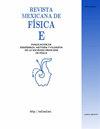Dark matter with n-body numerical simulations
Q4 Social Sciences
引用次数: 4
Abstract
The development of numerical N-body simulations have allowed studying the formation process and evolution of galaxies at different scales. This paper presents the fundamental concepts of N-body systems applied to the cosmological evolution of the ¤-Cold Dark Matter (¤CDM) model. To perform structure formation in the Universe, we provide an introduction to the basic equations and their implementation on the GADGET-2 software. We also present a simple guide to modifying this code. First, we briefly describe the dark matter in the Universe as well as the theoretical and experimental basis of the ¤CDM model. Then, we focus on the simulation codes and provide the equations that govern most of the N-body simulations to model the dark matter. We describe the Smoothed Particle Hydrodynamics method used for simulating the gas, star dynamics, and structure formation in these simulations. Then, cautiously, we guide the reader to the installation of GADGET-2 on a Linux-based computer, as well as to carry out a couple of examples to operate the code. Finally, by using a computational cluster, we show several results of a large structure simulation, analyze the outputs to display the matter power spectrum, and compare the outcome with theoretical predictions.暗物质与n体数值模拟
数值n体模拟的发展使得研究不同尺度星系的形成过程和演化成为可能。本文介绍了应用于¤-冷暗物质(CDM)模型的宇宙演化的n体系统的基本概念。为了在宇宙中进行结构形成,我们介绍了基本方程及其在GADGET-2软件上的实现。我们还提供了修改此代码的简单指南。首先,我们简要介绍了宇宙中的暗物质以及CDM模型的理论和实验基础。然后,我们将重点放在模拟代码上,并提供控制大多数n体模拟的方程来模拟暗物质。我们描述了在这些模拟中用于模拟气体、恒星动力学和结构形成的光滑粒子流体动力学方法。然后,我们小心翼翼地引导读者在基于linux的计算机上安装GADGET-2,并执行几个示例来操作代码。最后,通过计算聚类,我们展示了大型结构模拟的几个结果,分析了输出以显示物质功率谱,并将结果与理论预测进行了比较。
本文章由计算机程序翻译,如有差异,请以英文原文为准。
求助全文
约1分钟内获得全文
求助全文
来源期刊

Revista Mexicana De Fisica E
社会科学-科学史与科学哲学
CiteScore
0.80
自引率
0.00%
发文量
14
审稿时长
>12 weeks
期刊介绍:
The Revista Mexicana de Física (Rev. Mex. Fis.) publishes original papers of interest to our readers from the physical science com unity. Language may be English or Spanish, however, given the nature of our readers, English is recommended. Articles are classified as follows:
Research. Articles reporting original results in physical science.
Instrumentation. Articles reporting original contributions on design and construction of scientific instruments. They should present new instruments and techniques oriented to physical science problems solutions. They must also report measurements performed with the described instrument.
Reviews. Critical surveys of specific physical science topics in which recent published information is analyzed and discussed. They should be accessible to physics graduate students and non specialists, and provide valuable bibliography to the specialist.
Comments. Short papers (four pages maximum) that assess critically papers by others authors previously published in the Revista Mexicana de Física. A comment should state clearly to which paper it refers.
 求助内容:
求助内容: 应助结果提醒方式:
应助结果提醒方式:


